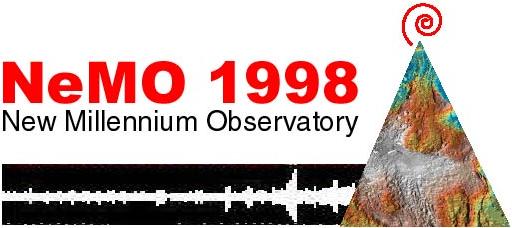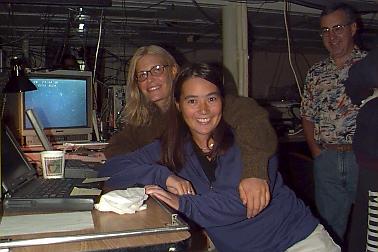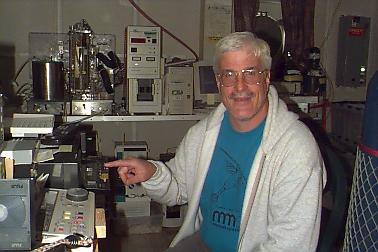WHAT'S NEW:
Other 1998 Axial Cruise Reports
(posted 8/13/98)
BACKGROUND:
Technology (ROV, ships, etc.)
Other 1998 Axial cruise reports
EXPEDITION:
Science Objectives
Calendar
Today's Science News
Participant Perspective
Teacher Logbook
EDUCATION:
Curriculum
Teacher Observations
Questions/Answers from sea
MULTIMEDIA:
(video clips, animations, sounds)

Logbook
August 28, 1998
August 28, 1998
Contents:
Science Report
Sorry, the science report is unavailable at the moment.
Listing of all Science News postings
Life at Sea: Participant Perspective
Graduate Students, University of Victoria

Ahoy from the NOAA ship, the Ron Brown! We're here sitting a top an underwater volcano called Axial Seamount. Our mission? To explore the deep. In particular, to seek out, observe, measure, and sample the spectacular life associated with hot water gushing out of the seafloor. These underwater hot springs are called hydrothermal vents. These vents spew water from temperatures close to ambient (which is about 2degC) up to 401degC. Most of the animals living around vents flourish in temperatures below 20degC. However, a vent creature has been discovered that thrives in water up to 80degC, the highest known temperature for any animal. Wow! That's like us living in a lobster pot. Not only do vent animals have to deal with high temperatures, but they are also exposed to chemicals and minerals which are normally toxic to most other life. On top of that, these guys live in the pitch black because sunlight cannot penetrate to these depths. That means no photosynthesis, which is the base of food chains for most other life on earth. So how do these creatures survive with no plants to eat? They depend on bizarre bacteria that use chemical energy in the vent water to produce organic carbon which in turn sustains them..
Who are "we"? We are Jean Marcus and Maia Tsurumi . Two graduate students studying various aspects of hot vent biology at the University of Victoria, Victoria, B.C., Canada. Various other researchers on the ship are interested in the microbiology, chemistry, and geology. But who's really interested in that boring stuff??? We like to study the cool critters found in this extreme environment. We are focusing on understanding the ecology of vent animals. I (Jean) am specifically looking at vent worms called polychaetes. I am trying to figure out what underlies their patchy distribution and abundance in a 60 m2 vent field on Axial Seamount. I (Maia) am also studying vent ecology. I am interested in all vent animals from the microscopic (but not the bacteria!) to the giant tubeworms at vent fields all over Axial Seamount and also two other locations on the Juan de Fuca Ridge. Two things I'm very curious about are the patchy distribution of some species along the Ridge and the controls on animal diversity in these crazy communities. On this cruise we are using a remotely operated submersible called ROPOS. We pilot the submersible from the ship and get real-time video, locations, and samples from the seafloor. That means we watch TV all day and night when the sub is roving around the bottom! Right now, we are over thirteen hours into our first dive and have already seen lots of strange things, including some newly formed vent sites and little scale worms munching on bacteria-covered rocks. On this dive, we hope to get a biological sample. This means that a robotic arm from the sub will reach out and grab a patch of animals, put them into a bullet-proof box (to protect them from the sub), and will eventually bring them to the surface. Shipboard, we sort through our sample, record our findings, and preserve the animals for future work back on shore. Oops, got to go--we've just been called back to the ROPOS control room!
Listing of all Perspectives postings
Teacher At Sea Logbook
August 28 - 1000 hours
 At 2150 hours last evening the ROPOS went into the water. By 0000 hours
virtually everyone on board was either in the hydro-lab ( action central for
this expedition) or sitting in front of one of the many video units scattered
throughout the ship. We were all watching the first returns from the bottom of
the Pacific Ocean. It's a little hard to describe the atmosphere and the
feeling. It did not feel all that different from watching the first astronaut
walk on the moon. Even the array of computers in the hydro-lab and the joystick
in the hand of the technician who was "flying" ROPOS over the bottom was
reminiscent of the Apollo flights. The big difference was that I was right
there where it was all happening, listening to the excited voices of the
scientists, some of whom are out on their very first expedition.
At 2150 hours last evening the ROPOS went into the water. By 0000 hours
virtually everyone on board was either in the hydro-lab ( action central for
this expedition) or sitting in front of one of the many video units scattered
throughout the ship. We were all watching the first returns from the bottom of
the Pacific Ocean. It's a little hard to describe the atmosphere and the
feeling. It did not feel all that different from watching the first astronaut
walk on the moon. Even the array of computers in the hydro-lab and the joystick
in the hand of the technician who was "flying" ROPOS over the bottom was
reminiscent of the Apollo flights. The big difference was that I was right
there where it was all happening, listening to the excited voices of the
scientists, some of whom are out on their very first expedition.
That's a message I want students to hear. Many of the people working out here are just barely out of college. Many are in their early 20's. If you are thinking about a career in marine science, or any science, the future is not very far in front of you. Now is the time to prepare yourself. A past student of mine, who is now a senior at MIT, would fit right in out here. She shares the characteristics that I see among these scientists. I have the distinct pleasure of working with a crew of young people who have taken the challenge and are running with it.
night, before exhaustion put me in my bunk, I had the opportunity to see milky water venting from inside the ridge. Shimmering waters were being emitted from several cracks and holes. This shimmering effect is caused by the density difference between the warm waters leaving the vents and the cold sea water which surrounds them. We also saw what seemed like acres of bacterial mats that were growing because of the rich supply of nutrients available in the vent water. The largest living thing I observed was a scale worm that appeared to be about 5 cm in length. It is difficult for a newcomer to judge the size of things because there is nothing of known size visible with which to make a comparison. We forget how important prior knowledge is in allowing us to understand what we see in the world around us!
As I prepare to go on my first official watch of this expedition, ROPOS is searching the bottom looking for markers left on the seafloor to point out areas of interest discovered on previous expeditions. Scientists hope to use ROPOS to free the instruments so that we can recover them at the surface. We did have one problem during the night. The chemical sampler known as SUAVE, developed some problems in its hydraulic system and was disabled. It is a very important player and will have to be brought back to the ship later today for repairs. Watch for more about SUAVE in the next couple of days. I will be interviewing the scientist who developed SUAVE, and will post a photograph as well.
0400 hours-
I am off watch until tomorrow. I, who cannot successfully program or run my own video at home, was given control of not one, but six video machines that document the discoveries we make. Today we saw many vents releasing warm water on the sea floor. We saw scale worms feeding on the bacterial mats, and a rat fish sitting on a rock not far from one of the vents. Scientists were really excited about seeing a palm worm. This organism has only been seen a few times in association with the most active vents, but today we observed a specimen more or less in the "middle of nowhere," as one of the scientists described it. Very exciting, and I'm told the best is yet to come. In the area known as "Ashes" we expect to encounter smokers. These smokers are the most active venting areas. I took a quick peek at the picture they took of me during my work session. Surrounded by all that sophisticated science gear, I'm about to press the button on the video machine. Tune in tomorrow.
Gene
Logbook of all Teacher At Sea postings
Question/Answer of the Day
Send Your Question to NeMO
Back to Calendar